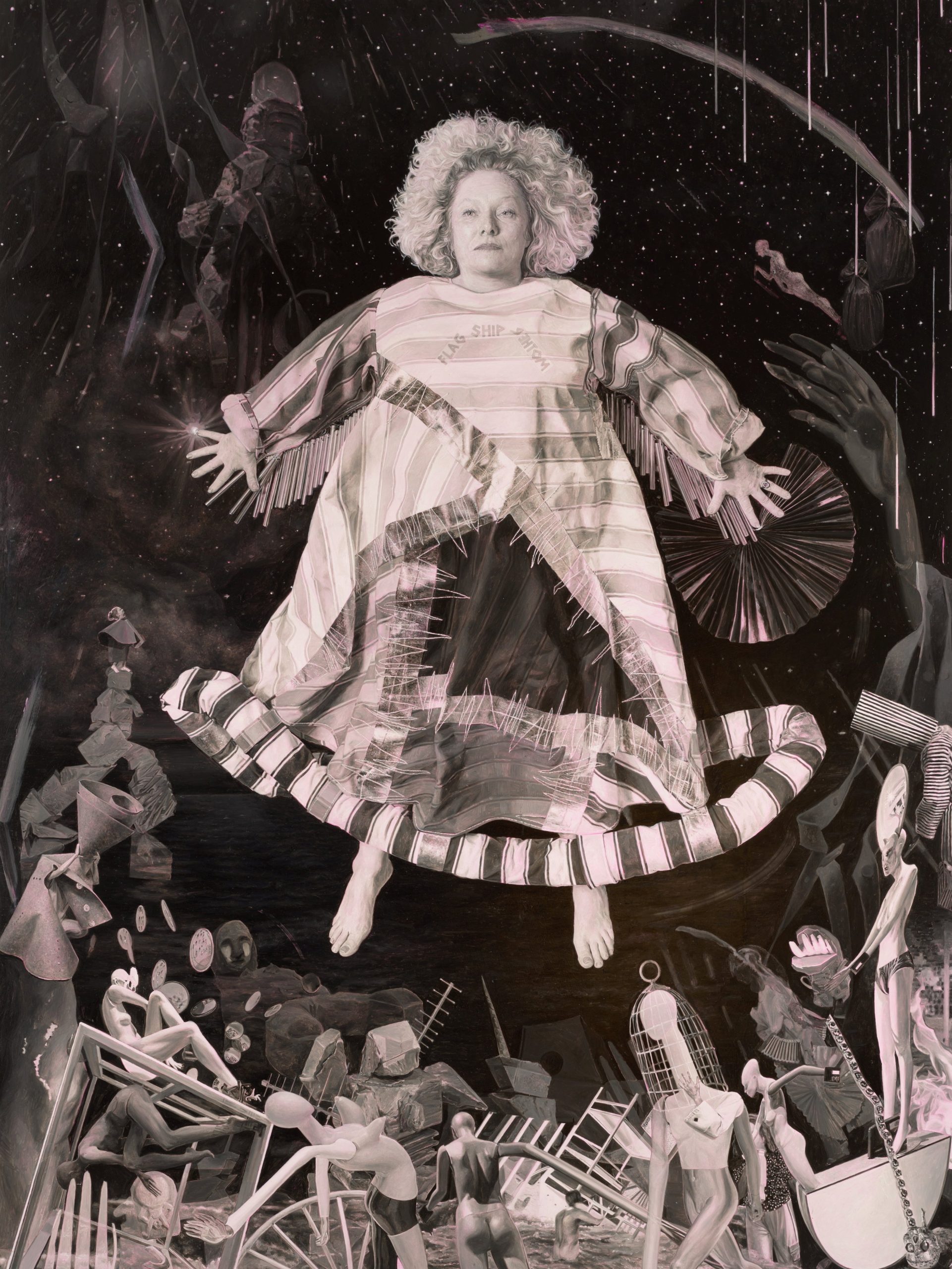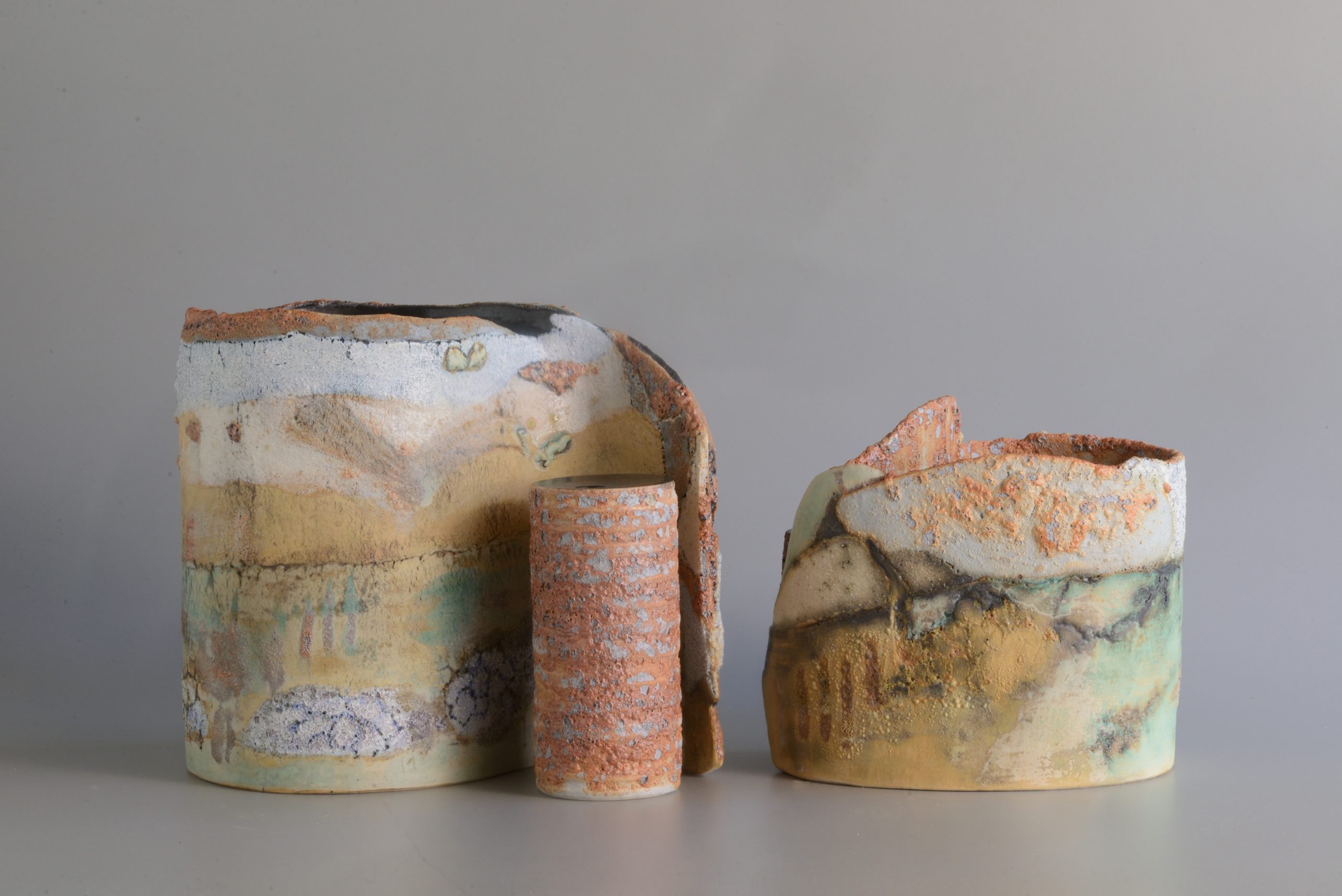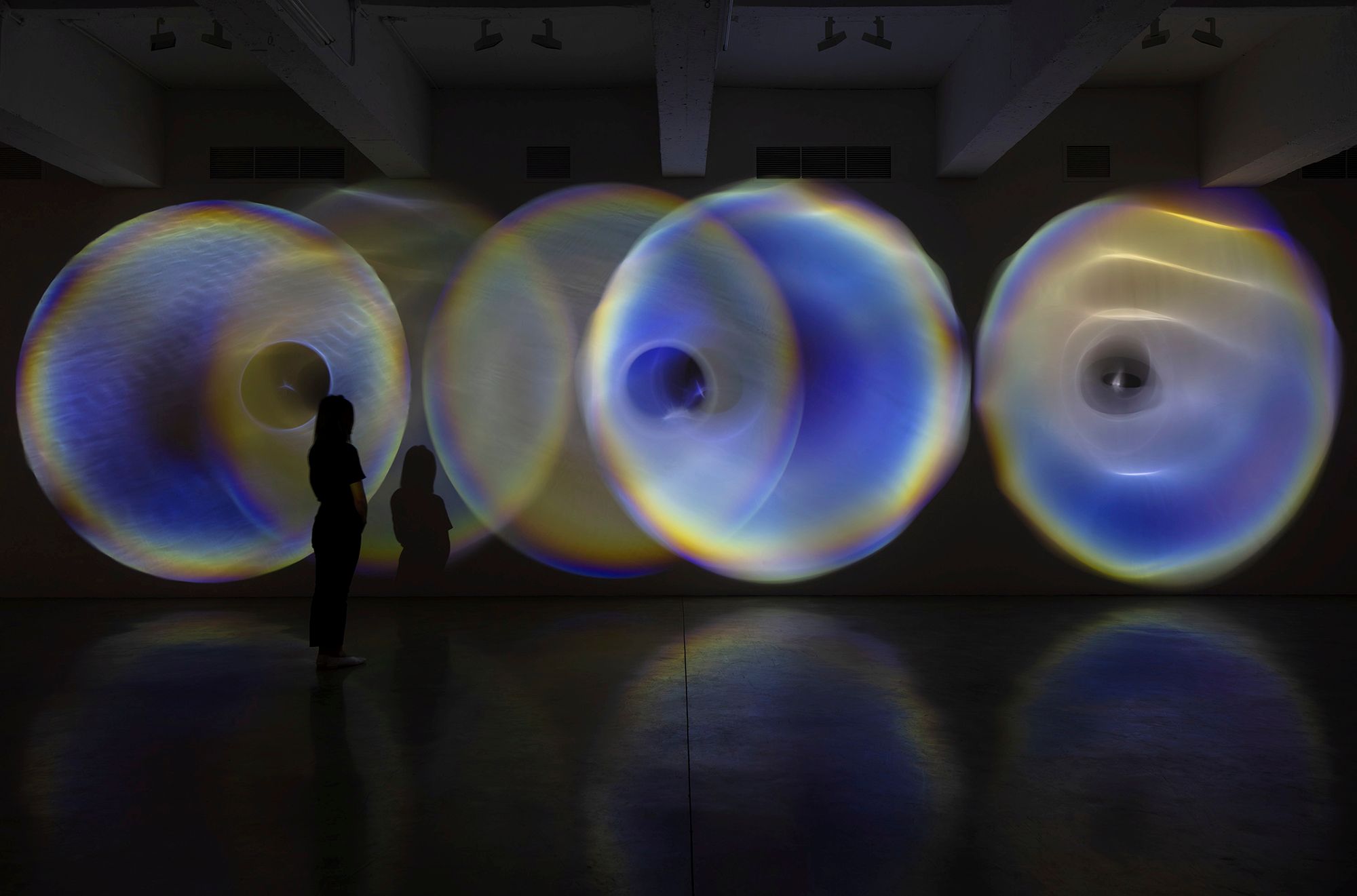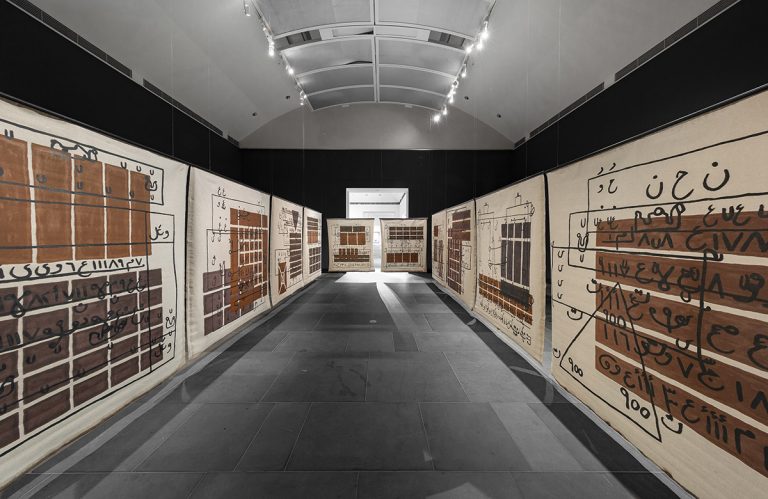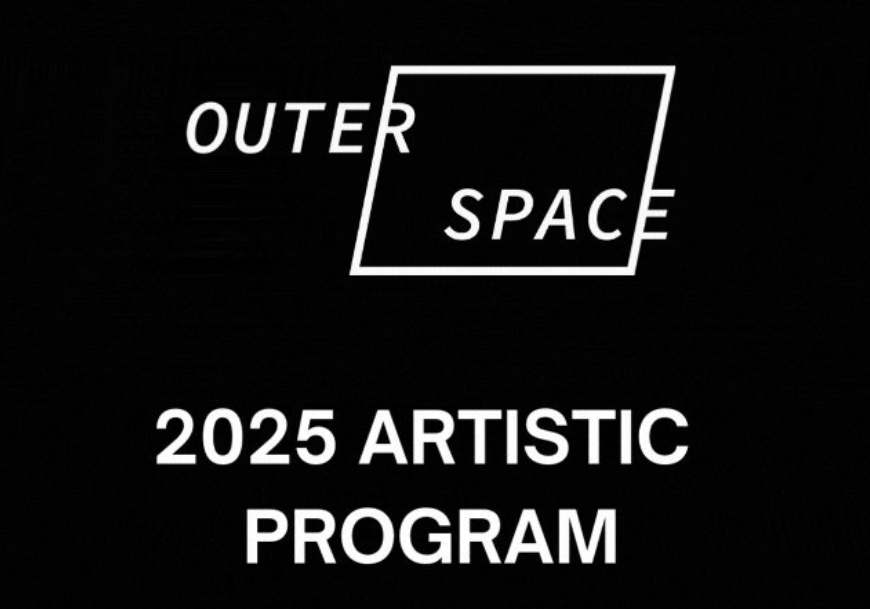
Alongside commercial and public galleries, as well as artworks commissioned for public places, unconventional exhibition spaces are part and parcel of Brisbane’s visual arts community. Artist Run Initiatives (ARIs) exhibit out of dilapidated Queenslanders, the back of trucks, underneath houses, and give impromptu performances in public spaces.
Approaching the Spring Hill house of Dirk Yates and Ellie Buttrose was not to be looking for the latest instalment in Brisbane’s ARI landscape, but for an exhibition of six paintings by local artist Paul Bai from his Between Me and the World series.[1] The works are all pre-existing, and were not commissioned for the show.
Though an expected one, I arrive at the home a stranger. Unlike ARIs and larger institutions, I need to be invited into the house in order to see the works. I become more conscious of myself, entering as a guest into the space of someone’s home.
And it is not a space that has been repurposed for art hanging. Bai’s works are hung around the home’s pre-existing features. Nothing was moved to make way for them. This reinvigorating of the relationship between art object, viewer, and exhibition space is a crucial methodology for critiquing Bai’s show.
The six works are all monochromes. A frame, which does not match the dimensions of the canvas, is laid across the middle of each monochrome and overlaps its left and right edges. The artist labels these works “spatial paintings.”[2] They are neither strictly sculptural nor painterly, and they explicitly interrogate ideas of conceptual and physical space. Such spatial considerations are amplified by the unorthodox space of the home, for this is solely a home and not an art gallery (and not home as ARI or commercial enterprise).
These works are physical exemplars of Bai’s concept of the Third Spatial Position.[3] This position works between the dichotomised poles of physical and conceptual space. It critiques this binary and its values, but does not seek to replace either of its terms. Indeterminacy is a key descriptor of the Position, the indeterminacy that defines being outside concrete physical or conceptual spatialities.[4] Yet, this exploration of indeterminacy yields certain values.
In existing between or beside these spatial poles, this position pinpoints the fundamental split between them which the viewer enacts. There is a gap, defined by an indiscernible action, which separates a physical object from its representation through language or its conceptual space (for example the perceived three-dimensionality of a flat painting as being separate from its actual two-dimensionality). This gap, this indiscernible tear or tentative rupture, also unifies these two poles, as both are distinct yet nevertheless interdependent. That is, a viewer perceives then appraises the apparent physical properties of an artwork while also forming, through language, a conceptual explanation of what they perceive and how they perceive it.
Hence, a unifying gap defines the Third Position’s indeterminate spatiality. There is an indiscernible action-as-lacuna that exists outside and in relation to conceptual and physical space. The spatial paintings allow the audience to understand how they rely on this act to divorce three spatialities from one other: the paintings’ own dual conceptual and physical spaces and the domestic reality of the home. The division between each is indeterminate yet visible. And the home of Yates and Buttrose is itself a third position, an ideal in-between setting for considering the strangeness of space.
The first work the viewer encounters upon being invited into this home is Between Me and The World (Without Leonard Cohen), 2016, which is situated on the left wall of the entrance hallway. Leonard Cohen serves as a general introduction to the exhibited works, though crucial developments occur in how the remaining monochromes interact with space or reinterpret the following visual qualities.
Leonard Cohen is a canvas of dark blue paint with an identically coloured frame laid across its middle section. The artist’s brushstrokes are visible along the monochrome’s uppermost horizontal segment and make visible the underlying white canvas, and this also recurs along sections of the frame. The blue paint halts when the frame’s two horizontal edges cross into empty space on the work’s left-hand side. The unadorned wood of the frame is here visible.
The dark blue acts as a seamless unifier of canvas and frame, as its application means there is no visible break between the two physical objects. The paint joins one with the other, physically extending the surface of the monochrome beyond its customary flatness.
The gaps between the frame and the canvas on the work’s left and right sides border small portions of space that are external to the painting. Other parts of the frame sit within the borders of the monochrome. The frame no longer concisely demarcates the beginning and ending of the work. It does not surround the monochrome but neither does the work wholly surround the frame. Combined with the layering of frame over canvas, this means the physical beginnings and endings of Leonard Cohen cannot be neatly defined. Exterior, domestic space is invited into the realm of the spatial painting, and begins to be absorbed by the artwork’s internal aesthetic logic. The physical work is evident and visible, but its corresponding conceptual space is not. Leonard Cohen’s separation from the world is uncertain.
The work problematizes the distinction between its interior spatial duality and the space of the home, inviting this latter, real space into its orbit (as opposed to a gallery’s white sterility which neatly separates the work from the world). Yet, the home does not fully contextualise the artwork as its inhabitants’ actions, for example the personal routines of Yates and Buttrose, do not directly relate to the work. Neither do the works directly impact such actions. So, while Leonard Cohen is contextualised by this space, engages with the space of the home through its semi-bordered intrusions, this is only ever a semi-contextualisation. The work exists in the space without being completely reconciled with it.
Leonard Cohen instigates this critique by repurposing the frame, that which the viewer usually relies on to make clear this separation. The frame is no longer a neutral barrier between the work and the world, but is indeterminate, tentative, and volatile. The space of the home enters into and breaks apart the physical and conceptual spaces of the artwork because it points to a space beyond that which includes the artwork. But all three are never fully constructed, deconstructed, or determinate within the orbit of the artwork. The unifying gap’s indeterminacy appears in the way the work never fully separates itself from the surrounding world, yet the viewer perceives it as ostensibly different.
Additionally, the pre-conditional spaces of the blank canvas and the unadorned frame, the work’s physical foundations, are presented as conditions of the complete artwork. They sit alongside the unbroken blue monochrome and its conjoined frame as deliberate additions to the spatial paintings. The unadorned pre-space which precedes the work’s blue space is seen as nonetheless being a part of the final work. Although mostly invisible underneath the monochrome, this preceding space is nevertheless there, present beneath the work’s more “complete” blue spaces.
That is, there was no a priori physical object before the application of paint made the work into a subjectified object with a conceptual space. Similarly, a physical space which exists before the conceptual and analytical power of language cannot be accessed by the human subject. Leonard Cohen’s a priori space is always part of the work’s final physical and conceptual form. The physical pre-space is a conceptual component of the work at all times, and this is physically revealed by Bai’s incomplete brushstrokes and sections of unadorned frame. The unifying gap is here visualised as the simultaneous difference and non-difference between the work’s before and after: its material preconditions and final (conceptual) manifestation.
The work most visible after moving on from Leonard Cohen’s visual introduction is Between Me and the World (No. 16), 2016. The spatial painting sits opposite the entrance hallway, and partially covers a doorway and an additional opening which joins the kitchen to the dining room. It is a yellow monochrome with a thin strip of blank canvas along its bottom edge. Similar to Leonard Cohen, the frame’s two horizontals are painted to the edges of the monochrome’s left and right sides. Bai’ brushstrokes are also visible throughout the work.
What sets No. 16 apart from Leonard Cohen is its situational qualities. The former’s placement in the opening between two rooms means its anterior and part of its posterior are visible for visual analysis. Any appraisal of No. 16 relies on the transitory movement of the viewer. As with a sculpture, the subject needs to move to the back of the work in order to critique it completely.
But such a back-and-forth movement is identical to the routine movement of someone from the kitchen to the dining room or vice versa. That is, the movement of the viewer from the front to the back of the work does not differentiate itself from other domestic movements in the home’s space (even if the subject’s focus differs).
The action which reveals the unique physical properties of the work does not exist as its own unique movement. This fuses the beholding of the work with the ignoring of the work, the latter tied to the personal movements of Yates and Buttrose. Hence, the split which separates these two actions is indeterminate. This means that the work, its physical appreciation by the human subject, is defined by an indiscernible conceptual gap which separates two identical physical actions.
The other monochrome which is eminently visible after exiting the entrance hallway is Between Me and the World, No. 18, 2016. The red sculptural painting is situated in a corner of the lounge room. The surface of the monochrome is here further reduced as its right and bottom border are sections of bare canvas which form a flipped “L.” The frame’s red painted section also forms an “L,” but this shape is rotated ninety degrees clockwise from its corresponding position on the canvas.
The bottom edge of the frame and canvas sit on metal supports which are attached to the rear wall. There is a further eroding of the demarcation between the work and its domestic surrounds. This deliberately relaxed presentation, the languid lean of the work against the wall, mimics the similarly relaxed aesthetic of the home. A pile of books sits on a nearby stool in an irregular pile, and No. 18 does not seem to be held in a higher regard than such objects.
Another outcome of the work’s languid lean is that the canvas and frame are no longer physically fused as they were in the previous two works. This emphasises that within the exhibition the canvas and frame are a conjoined conceptual entity (tentatively extending the surface of the monochrome), while they are also two separate physical objects.
With their similar shapes layered over one another, the frame and canvas would represent a lacuna and its filling in. Though, as the size of the canvas dwarfs that of the frame’s this would only be conceptually possible through an imaginative projection. Hence, the work refuses to physically fill-itself-in, yet simultaneously alludes to this very possibility through a conceptual hypothesis. No. 18 therefore pinpoints the unifying gap that each of the works relies on: the way physical and conceptual space are mutually interdependent yet always divergent.
Between Me and the World (No. 3), 2015, is partially hidden from the viewer when they exit the entrance hallway, sitting on the upper landing of a set of stairs immediately to the viewer’s right. A dark blue monochrome which verges on black, its frame again lies across its middle section.
No. 3 sits in an in-between physical space. Caught between the home’s upstairs and downstairs, it is part of neither. From the top and bottom floor, it is not entirely viewable. To gain a better vantage point, the viewer must traverse the stairs and stand at various points on one of its two sets, or come into close proximity with the spatial painting on the landing itself. The work’s surrounds never yield an ideal appraisal position, and the viewer is subject to the way the home’s architecture frames the work. The gap between the work and the world vanishes as the world does not allow for the work to be seen.
The artwork is physically separate from the world, yet is conceptually subsumed to the home’s space (though this is of course only ever partial). The home physically frames the work and alters how it can be approached by the viewing subject. Both the home and the work exist simultaneously, and their respective beginning and end are reliant on a physical and conceptual border that is never precisely demarcated. The unifying gap here appears in the way the home begins to shape No. 3 while always remaining external and actively different to the work itself.
Opposite the entrance hallway is another hallway which leads to the home’s posterior and back garden. In this narrow space is Between Me and the World (No. 1), 2015. A black monochrome, the work is constructed like Leonard Cohen. Here though, there is the slight extending of the left and right sides of the frame, meaning they encapsulate more of the surrounding domestic space.
Simultaneously, the work is situated in a narrow hallway which does not yield an easy appraisal position (like No. 3’s placement). The viewer and the work are brought into close proximity with one another. The former is pushed into a hat rack at their rear, and is brought closer to the work just as the work seeks to resist this intimacy and extend beyond this small space. That is, the larger frame attempts to move the work further out into the home, and creates this conceptual effect in comparison to the other works in the exhibition. But this comparative extension is denied by the claustrophobic installation of the work. No. 1 invites a reading of expanded conceptual space while being physically confined in domestic space, and the unifying gap appears as the binder of the two halves of this contradiction.
The final work in the exhibition is the most isolated. Between Me and the World (No. 7), 2015, is situated at the back of the home in the bathroom, completely out of sight of the other spatial paintings. It is placed over a long, rectangular window. No. 7 covers the vertical distance of the window and its frame, and is situated at this opening’s left end.
The height of the spatial painting’s frame means it almost perfectly sits within the lacuna of the receding window. No. 7 sinks into this space, absorbed into its retreating dimensions. But the work only just begins to be sucked into this recession. The uncompromising black of the canvas and the black components of frame are obdurately separate from the window, immovable and isolated in their own void-like nature.
The pre-space of the work, its unadorned frame, is that which begins to be absorbed by the domestic space. The unifying gap separates these two conceptual spaces, but Bai equates their visual value by allowing for the bare frame to be sucked into this surrounding space via the recessional window. The homely space of the viewer becomes the underlying foundation of the painting, and vice versa, as the conceptual gap between both is made indeterminate.
Inadvertently, the works have acted as our guide through the house. They invite you into separate rooms, link rooms together, and curate the space of the home and the subject’s journey through it. You begin to know this homely space and your own place within it better. The cold, arch-modernist monochrome becomes a sort of housewarming device, conceptually allowing the viewer into the home through a tour of the built environment. Just as the works are never fully resolved with their surrounds, the viewer moves into a similarly in-between space. They are no longer really a stranger in in the home, but a somewhat more acquainted part of it. There is an indiscernible turning point which defines the transformation of the subject’s place within the Yates and Buttrose home (as there is in the experience of any new space), from one of strangeness to feeling at home
Written by Simon Brigden
[1] The exhibition ran from the 17th December 2016 – 4th February 2017.
[2] Many thanks to Paul Bai, Dirk Yates, and Kim Machan for their time and energies in discussing the exhibition with me in person and via email.
[3] Paul Bai, “A Brief Introduction to the Concept of Third Spatial Position,” in LANDSEASKY, ed. Kim Machan (Brisbane: Media Art Asia Pacific Inc. and OCAT Shanghai, 2015), 56.
[4] Bai, “Third Spatial Position,” 57.
Review written for the exhibtion – New Spatial Paintings by Paul Bai. 17th December 2016 – 4th February 2017. Private residence, Spring Hill.

